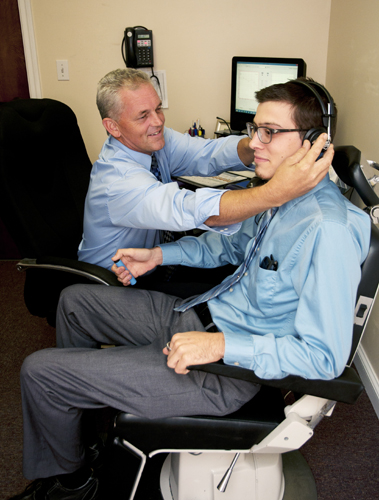
Among the maladies associated with the aging process, hearing loss is one of the most troublesome, for the sufferer and for his or her friends and family. Ironically, while hearing loss can cause frustration, anger, denial, even generational conflict, it is also one of the most “fixable” health problems.
Even so, people still frequently avoid seeking a solution to their hearing loss for several reasons: Cost can be one, but frequently, it can be a matter of pride, a perception that wearing a hearing aid is a stigma, feels awkward and “makes me look old.”
As more Americans are choosing to remain in the workforce longer, and hearing loss is increasing among younger people, recognizing and treating hearing loss sooner rather than later becomes more important.
The good news is that hearing technology continues to advance by leaps and bounds, allowing people to hear better virtually everywhere they need to – in all directions and sound environments, even under water, which is especially helpful in an area as heavily focused on water activities as Sebastian. Today, most hearing aids are digital, wireless, almost invisible and, with rechargeable systems, users don’t have to deal with constantly changing batteries.
With a significantly retirement-age population in the Sebastian area, hearing loss is a problem frequently seen by family physicians and hearing instrument specialists, such as Monte Dotson of the Monnett Hearing Center. Dotson talked about today’s cutting-edge technology and how an individual can be tested to determine his or her level of hearing loss.
People, especially men, tend to deny they have a hearing problem. “I find that often guys will say ‘it’s just wax’,” Dotson says “Or they get mad and say people are mumbling. A man with severe high frequency loss may not hear his wife, because her voice has a higher pitch.
“Overall, around 70 percent of hearing losses I see,” he notes, “are in the high frequency range. Speech is typically in the 500 to 1,500 Hertz range. Consonants, which are in the higher frequencies, made with the lips and teeth, are the most frequent loss area. I see a lot of men who have been in the military service. Hereditary loss seems to affect women more. And aging is a factor for everyone. Sometimes, of course, hearing loss can be caused by disorders of the ear or infection, but that’s minimal, maybe one in 10.”
The technician first checks for any diseases or damage to the ear, in which case he will refer the patient to a specialist, family GP or, for an event such as Q-tip or other object lodged in the ear, the ER. If wax buildup is found to be the problem, the technician will carefully clean the ear. When those causes of hearing loss are eliminated, Dotson says, audiometric testing is conducted.
The patient wears headphones, connected to an audiometer, which produces tones at specific frequencies and set volume levels, sent to each ear, independently. The audiologist or hearing aid specialist plots the loudness, in decibels, and the frequency (or pitch) in Hertz on a chart (audiogram.) The individual being tested indicates when he or she hears each tone, which the technician plots on the chart. The resulting line graph clearly shows which frequencies are not being heard and what degree of hearing loss may be present.
Normal hearing for humans is about 20-25 decibels (dB) or less, and an individual in that range should be able to hear sounds as soft as a dripping faucet or ticking clock. Hearing worsens as the number increases. A mild to moderate loss falls within about a 35 to 65 dB range, which includes such sounds as normal conversation; and a moderately severe to severe loss drops into the 65-90 dB range, within which fall such sounds as vacuum cleaners, babies’ cries, telephones, pianos.
“At 100,” which includes lawnmowers, motorcycles and airplanes, “an individual is considered deaf,” says Dotson.
Because virtually all of the hearing aid manufacturers and distributors have access to the same technologies, excellent devices are readily available, manufactured by a few big companies, and distributed directly through the manufacturer or under a variety of brand names.
Today’s cutting-edge hearing devices are far from yesterday’s simple amplifiers, which were often highly visible and annoying to the wearer. Now they can be programmed precisely for each individual’s specific hearing loss requirements. When the level of loss is determined, a device is individually fitted, and, in most cases is virtually invisible, sitting snugly behind the ear and curving to fit inconspicuously into the ear. Based on the level of loss, it can be an “open fit,” or can fit over the ear drum and completely seal the ear canal.
The device, Dotson explained, is initially programmed based on the patient’s input and audiogram data. After a period of adjustment, the hearing device automatically reprograms itself, based on the information it has gathered automatically, via a computerized chip, recording the patient’s typical daily noise exposure and adjusting as required.
It typically takes a 30- to 60-day period of adjustment, Dotson said, for the brain to accept the change. If the hearing loss has been severe, the new, normal hearing capability can be stunning at first for individuals who have grown accustomed to their condition.
“Flushing a toilet will sound like Niagara Falls, the car’s turn signal sounds like a hammer banging. People are just absolutely amazed.”
Dotson’s advice is simple and straightforward: If a person suspects a hearing loss, “get a screening. There’s no charge. Come in and see us. Get checked out.”
The Monnett Center for Hearing is one of the area businesses which offer hearing screening and hearing devices.



